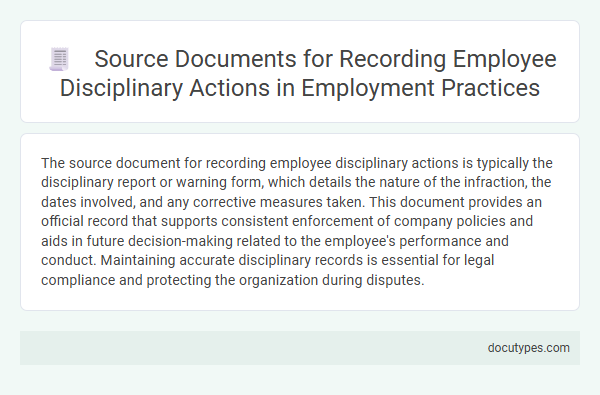The source document for recording employee disciplinary actions is typically the disciplinary report or warning form, which details the nature of the infraction, the dates involved, and any corrective measures taken. This document provides an official record that supports consistent enforcement of company policies and aids in future decision-making related to the employee's performance and conduct. Maintaining accurate disciplinary records is essential for legal compliance and protecting the organization during disputes.
Introduction to Employee Disciplinary Source Documents
Employee disciplinary source documents serve as the official records for tracking any infractions or behavioral issues in the workplace. These documents provide a clear and consistent way to document incidents, ensuring fair treatment and legal compliance.
Your organization relies on these source documents to maintain transparency and support decision-making throughout the disciplinary process. Common examples include written warnings, incident reports, and performance improvement plans.
Importance of Accurate Documentation in Employment Practices
What Is the Source Document for Recording Employee Disciplinary Actions?
The primary source document for recording employee disciplinary actions is the disciplinary report or incident report prepared by the employer or supervisor. Accurate documentation in these records is crucial for ensuring legal compliance, supporting fair employment decisions, and maintaining clear communication regarding employee conduct.
Why Is Accurate Documentation Important in Employment Practices?
Accurate documentation protects both the employer and employee by providing a clear, objective account of disciplinary measures. This information supports consistent enforcement of workplace policies and can be vital evidence in resolving disputes or wrongful termination claims involving your organization.
Types of Source Documents for Disciplinary Actions
Source documents for recording employee disciplinary actions are essential for maintaining accurate and legal records. These documents provide details about the incident and the measures taken by the employer.
- Written Warning - A formal document outlining the specific misconduct and consequences issued to the employee.
- Incident Report - A detailed account of the event leading to disciplinary action, often prepared by a supervisor or HR personnel.
- Employee Statement - A written explanation from the employee's perspective regarding the incident under investigation.
Your thorough documentation ensures accountability and supports fair employment practices.
Incident Reports and Their Role in Disciplinary Records
The source document for recording employee disciplinary actions is typically the incident report. Incident reports provide a detailed account of the event that triggered the disciplinary measure, ensuring accurate and objective documentation. Your disciplinary records rely on these reports to maintain consistency and support fair decision-making processes.
Written Warnings and Formal Notices
The source document for recording employee disciplinary actions primarily includes written warnings and formal notices. These documents serve as official records to track employee conduct and disciplinary measures.
- Written Warnings - A written warning details specific employee misconduct and outlines the required corrective actions.
- Formal Notices - Formal notices communicate serious disciplinary steps and may precede further action such as suspension or termination.
- Documentation Purpose - These records support consistent enforcement of company policies and protect your organization legally.
Performance Improvement Plans as Disciplinary Evidence
The source document for recording employee disciplinary actions is crucial for maintaining accurate records of performance issues. Performance Improvement Plans (PIPs) serve as formal evidence in documenting disciplinary measures and outlining expected improvements.
PIPs provide clear, written feedback on employee performance deficiencies and the company's expectations. These documents include timelines and specific goals to address the issues effectively. PIPs are essential for legal compliance and support in case of disputes related to disciplinary actions.
- Performance Improvement Plan (PIP) - A structured document detailing employee performance issues, corrective actions, and improvement timelines.
- Documentation of Expectations - PIPs specify the performance standards employees are required to meet within a set period.
- Evidence for Disciplinary Records - PIPs serve as formal proof of communicated disciplinary actions and efforts to support employee improvement.
Employee Acknowledgement and Signature Forms
The source document for recording employee disciplinary actions is typically the Employee Acknowledgement and Signature Form. This form serves as official proof that the employee has been informed of the disciplinary issue and understands the consequences. Your signature on this document confirms receipt and acknowledgment of the disciplinary action taken.
Maintaining Confidentiality in Disciplinary Documentation
The source document for recording employee disciplinary actions is typically the disciplinary report or action form completed by a supervisor or HR representative. This document provides an official record of the incident, including details of the violation, investigation, and corrective measures taken.
Maintaining confidentiality in disciplinary documentation is essential to protect employee privacy and comply with legal requirements. Access to these records should be restricted to authorized personnel only. Proper storage, such as secure digital systems or locked physical files, helps prevent unauthorized disclosure and ensures the integrity of sensitive information.
Legal and Compliance Considerations for Disciplinary Records
The source document for recording employee disciplinary actions is typically the official disciplinary report or memo created by the HR department or management. This document details the nature of the infraction, the date, and any corrective measures taken.
Legal and compliance considerations require that these records are accurate, confidential, and stored securely to protect employee privacy and support potential future investigations. You must ensure the documentation aligns with labor laws and company policies to avoid legal disputes.
What Is the Source Document for Recording Employee Disciplinary Actions? Infographic

